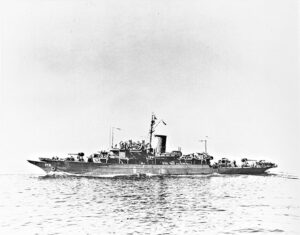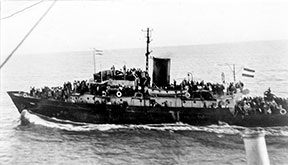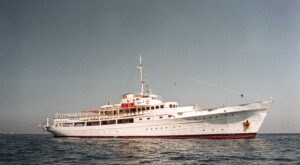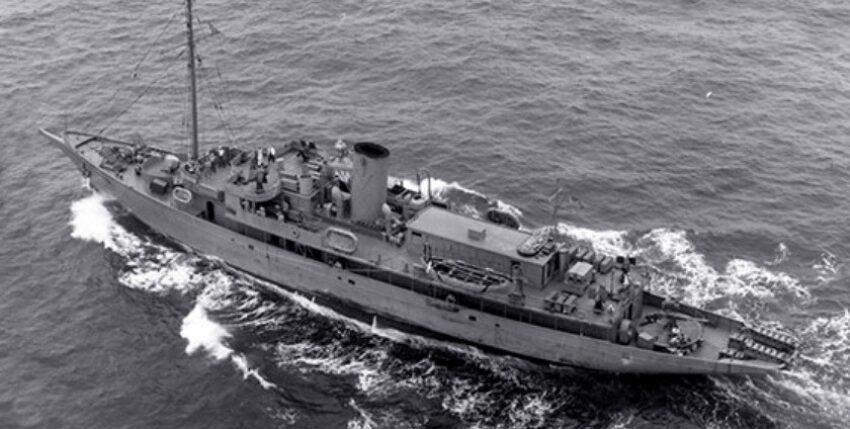Rarely had a yacht from the Krupp Gemania shipyard in Kiel led such an adventurous life as the luxury yacht ARGOSY. It began as a luxury yacht, spanned four wars and ended as it had begun many years earlier.
In the midst of the global financial crisis of the 1930s, the Germania shipyard delivered the ARGOSY in 1931. While the New York Stock Exchange collapsed in 1929, huge fortunes evaporated and countries went bankrupt, the wealthy could still afford a brand new luxury yacht. For example, Charles A. Stone from the New York bank and brokerage firm Hayden-Stone.
In 1935, one of the biggest names in the yachting world and industry bought the ship designed by Cox & Stevens. When Sir Thomas Sopwith needed a large yacht as a tender for the ENDEAVOUR, his Americas Cup challenger in the J-Class, he bought the ARGOSY without further ado and renamed the ship VITA. She accompanied ENDEAVOUR on the trip across the Atlantic and served as the mother ship during the Cup off Newport, Rhode Island. Sopwith kept the VITA until 1937, when he had the even larger motor yacht PHILANTE - today the Norwegian royal yacht NORGE - built for himself.
Spanish gold
Now it became breathtaking: the new owner of the VITA, Marino Gamboa, was actually a front man for Juan Negrin, the Republican Prime Minister of Spain during the Spanish Civil War. He initially used the ship for his own amusement. But then the Republicans cleared out the Spanish treasury and the Spanish banks and loaded the enormous amount of gold and jewellery in 120 crates worth 300 million dollars onto the VITA. Under the US flag, they steamed off to Vera Cruz in Mexico - only to argue about the money. Rumours are also circulating that the VITA was also used to smuggle weapons.

USS Cythera (PY-31), Photo: Naval History and Heritage Command
After the outbreak of the Second World War and the USA's entry into the war, the US Navy purchased the ship and put it into service in 1942 as the USS CYTHERA (PY-31). Intended for service in the Gulf of Mexico and on the American east coast, she led convoys there until 1943. The Navy then used her for submarine hunting exercises and sonar tests with submarines. At the end of the war, she sailed to New York and was decommissioned there in 1946.
With the BEN HECHT to Israel
And thus began a new adventure: the clandestine immigration of Jews to Israel. The American League for a Free Palestine - supported in the background by Eleanore Roosevelt - collected money to buy one of the ships that would take Jews to Palestine. However, the British Mandate wanted to prevent this with all its might. With the money raised, the Tyre Shipping Company - in reality owned by the Zionists - bought the CYTHERA and renamed it first ABRIL, then SATIRA and finally ABRIL again. The conversion for the new purpose took place in Brooklyn's Gowanus Canal, as she was to accommodate considerably more than the 15 passengers for whom she was originally intended.
The ABRIL left New York on 27 December 1946. The evening before, FBI agents had searched the ship because they suspected weapons on board that were to be smuggled to Palestine. Instead, they only found hundreds of life jackets. Under Captain Robert Levitan, the 21-strong crew of American volunteers steamed on to the south of France. They left Port-de-Bouc in March 1947, the decks crammed with around 600 Holocaust survivors - 284 men, 193 women, 29 children and three journalists. The conditions on board were difficult, but there was enough to eat because a supporter of the campaign had donated 2,000 pounds of kosher salami. At sea, the ship was given a new name: BEN HECHT. It was christened in thanks to the songwriter and film lyricist of the same name, one of America's best, who raised a million dollars for the ship with his theatre play "A Flag is Born". The voyage to Haifa came to an abrupt end when two British destroyers intercepted the BEN HECHT, soldiers boarded the ship and towed it to Haifa.
It was dramatic. Crew member Jeno Berkovitz recalled: "British soldiers with red berets - we called them 'Red Devils' - jumped on board. They pushed me aside and quickly took control of the ship. A photographer from 'Life' magazine was beaten by the boarding party while taking photos, three Britons died and several were injured trying to catch passengers who had jumped overboard."
After the German concentration camp, the Holocaust survivors ended up behind British barbed wire in a prison camp on Cyprus. They languished there for over a year until the state of Israel was founded. The crew of the BEN HECHT was arrested and sent to the notorious Acre prison. To London's annoyance, the arrest of the crew members became the target of fierce criticism from members of the American Congress, the American press and the American Jewish community. After imprisoning the sailors for a month, the British decided they were more trouble than they were worth and put them on a ship to New York.

the flag of Israel on the bridge and the flag
Honduras at the rear, photo: palmach.org
After the end of British rule and the declaration of independence, Israel had to fight for its freedom. The BEN HECHT became part of the young Israeli navy as INS MAOSZ-K 24 (Bulwark) and, as a member of the Israeli fleet, was one of the few backbones of naval warfare. Among other things, the MAOSZ was involved in the sinking of the Egyptian flagship EMIR FAROUK. In 1956, she had to take part in the Sinai War once again.
From the ferry to the luxury yacht
After that, however, she returned to civilian life. At the age of 25, she was actually still in her prime. She was bought by an Israeli businessman who used her as a cargo ship for a short time. He soon sold her on to the Italian ferry company Navigazione Libera del Golfo. Once again there was a new, very impressive name: SANTA MARIA DEL MARE. It now belonged to a ferry that sailed the Gulf of Naples for fourteen years, but was barely recognisable as the former ARGOSY.
That was about to change. In 2008, an Italian owner was found who wanted to convert the ferry back into a luxury yacht and sell it for 15 million dollars. First, the ship was once again given a new name: ROSSY ONE. Then the thorough restoration began, which included replacing 80 per cent of the underwater hull. The dilapidated electrics, pumps and valves, all pipework, engine, shaft and propeller were replaced and the ROSSY ONE was given a new teak deck. An Italian star designer was responsible for revising the interior design. In the end, 90 per cent of the work was completed. This cost a huge amount of money, which, together with the consequences of the financial crisis, broke the owner's back in 2011.
Once again the yacht changed hands and once again there was a new name: WHITE LADY. But no new future for the time being. She was offered as a rare opportunity on the charter market for three million euros, but without success. So the lady was laid up in 2014 and bobbed along in the harbour of Naples for another few years. But the tide turned. In early 2022, the Oldenburg newspaper "Nordwest Zeitung" and then the "SuperYacht Times" reported that ARGOSY had been spotted in Brake harbour. She is now being refitted in Lemwerder. The new owner is allegedly an unnamed European. On this occasion, the "SuperYacht Times" commented on the history of the ship: "This latest development and her arrival in Germany suggests that the completion of her restoration and the relaunch of this valuable piece of interwar maritime history may finally be concluded." Let's hope so.

in the Gulf of Naples, Photo: GL Watson
Jürgen Rohweder










